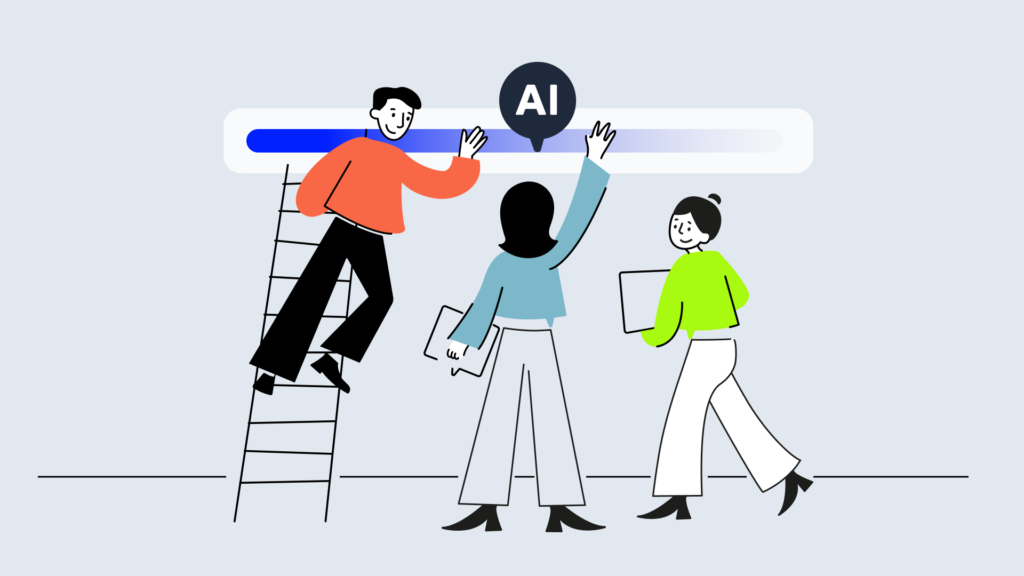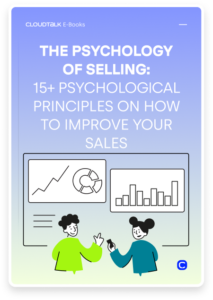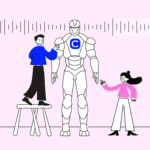AI in CX: Insights from 11 Experts on Avoiding Costly Mistakes

AI isn’t just nice to have when it comes to enhancing customer experience in 2023. It’s a must. With the growing expectations of modern-day consumers, you need to deliver swift, personalized experiences.
The technology helps you save resources, streamline operations, and stay ahead of your competition. However, using it incorrectly can also carry a heavy cost.
Make sure you only get the best AI offers with the expert opinions of 11 industry leaders using these advanced solutions to transform their operations as we speak.
The Defining Role of AI in Shaping Customer Experiences
Customers today expect 24/7 customer service, personalized interactions, and quick resolutions. AI systems, from chatbots to predictive analytics, are making these expectations a reality.
They amplify the quality of interactions and drive tangible business results by providing real-time insights and automation.
In the last few months, many companies have decided to take the leap of faith and outsource much of their operations to AI to offer customers instantaneous, relevant feedback and set a new industry standard. It’s undeniable: AI is reshaping how we connect, serve, handle data-driven customer experience and build customer relationships.
The Undeniable Case for Embedding AI in Your CX Strategy
In the competitive landscape, you need to be innovative, relevant, and responsive. Holding onto what used to work won’t suffice. That’s why implementing AI as part of your CX strategy is crucial. After all, it offers unmatched personalization, consistently high-quality interactions, and the predictive power to anticipate customer needs.
AI isn’t a luxury in this dynamic market; it’s your ticket to excellence.
Key Advancements AI Brings to Customer Experience
Navigating the rapidly evolving digital terrain in 2023 can be challenging. Thankfully, AI can be a game-changing tool that reshapes how we engage with customers. Let’s dive into the benefits of bringing AI into your CX strategy.
AI offers a multitude of benefits to businesses:
- Real-time Analysis: AI doesn’t just collect data – it makes sense of it. This allows you to gain actionable insights into customer preferences and behaviors.
- Tailored Interactions: AI aids in crafting personalized experiences. Every recommendation, message, or offer can be tailored to individual customer profiles, enhancing engagement.
- Operational Efficiency: Through automating repetitive tasks, AI ensures that support teams can focus on complex issues, improving the overall efficiency of the business.
- 24/7 Support: With AI-driven systems like chatbots, you can provide instant responses every hour of the day and save your customers’ time.
- Data-Driven Decisions: The insights provided by AI empower businesses to make informed strategic choices, enhancing their offerings and customer relations.
- Cost Efficiency: AI integration can lead to significant cost savings by streamlining processes and reducing overheads, like writing texts with AI tools to improve customer support messages.
11 Expert Opinions on Optimizing CX with AI
We’ve spoken at length about the theory of artificial intelligence in the context of customer experience. But what’s the reality? To find out, we asked 11 industry leaders four simple questions. And here’s what they have to say.
CloudTalk
1. How has AI helped/is helping you to optimize CX in your business?
One of CloudTalk’s main objectives is to amplify human potential with AI automation. As such, we’ve been using artificial intelligence in several areas of our operations and are even working on new AI solutions in our software to optimize customer service for us and our users alike.
At CloudTalk, we’re using AI to:
- Automate call transcriptions to save agents’ time and give employees reliable insights into our customers’ needs and desires.
- Evaluate customer emotions during interactions, assess how efficient our teams were in addressing them, and improve future performance.
- Collect and analyze large data sets of customer information to predict future behavior and trends.
- Optimize coaching and agent onboarding to make managers’ lives easier.
2. What are the common pitfalls or costly mistakes you’ve observed when implementing AI-driven CX solutions?
The commercial use of AI in customer service is still in its infancy; consequently, the industry is rife with potential pitfalls. The mistakes we’ve been doing our best to avoid so far include:
- Rushing to implement AI-based solutions into your operations without due planning and preparation.
- Overestimating benefits and forgetting the value of actual humans.
- Not having a sufficient data set to fuel the AI tool’s operations.
- Ignoring necessary employee training for the specific tool.
- Underestimating the needed deployment and maintenance budget.
3. What lessons have you learned from those mistakes?
We first needed to realize that AI is not a magical cure-all for CX inefficiencies, nor a replacement for employees. To be effective, AI tools need a human touch from conception and planning to execution and daily operations.
These revelations forced us to reevaluate our entire approach to AI, leading us to adopt a philosophy of empowering human potential.
It isn’t feasible to do everything all at once without negatively impacting your existing customer experience isn’t possible. Thus, CloudTalk became much more purposeful in its onboarding and deployment of AI.
We involve experts from all fields in the planning and decision-making, including sales, marketing, product, and others. This allows us to better anticipate likely costs (finances, human resources, time, etc.), prepare for potential issues, and create solutions that make money, not waste it.
4. Regarding the future of AI for CX in SaaS businesses – What are some emerging trends or technologies CX experts should closely watch?
The possibilities of AI are so vast that we currently can’t accurately predict the trends and technologies that’ll take over the industry as the solutions become more sophisticated. However, there are a few we’re keeping a close eye on.
These include:
- AI-powered customer support chatbots with full voice support
- Predictive analytics for customer behavior
- Customer service workflow automation
- Virtual assistants for agents.
2. Mitesh Kariya, Product Marketing Manager at Refrens.com
1. How has AI helped you to optimize CX in your business?
The tool we chose to experiment with in Referens was pre-filed email templates in a lead management system. Here’s how that went:
Metrics Before Implementation
- Average Time Spent on Drafting Emails: 15 minutes
- Follow-up Rate: 60%
- Conversion Rate: 25%
Metrics After Implementation:
- Average Time Spent on Drafting Emails: 5 minutes
- Follow-up Rate: 80%
- Conversion Rate: 35%
Introducing AI-powered pre-filled email templates allowed our users to quickly and efficiently follow up with leads. This led to a 66% reduction in the time spent on drafting emails, a 33% increase in the follow-up rate, and a 40% increase in the conversion rate.
2. What are the common pitfalls or costly mistakes you’ve observed when implementing AI-driven CX solutions?
- Lack of User Training: Not adequately training users on effectively using the new features can lead to underutilization.
- Overcomplication: Making the AI features too complex can overwhelm users and deter them from using the system.
- Data Privacy Concerns: Not addressing data privacy can lead to user mistrust, affecting adoption rates.
3. What lessons have you learned from those mistakes?
- Initial Scenario: Initially, the pre-filled templates had too many customization options, confusing users.
- Outcome: User engagement with the feature was lower than expected.
- Lesson Learned: We simplified the customization options and provided a quick tutorial, which led to increased user engagement and satisfaction.
4. Regarding the future of AI for CX in SaaS businesses – What are some emerging trends or technologies CX experts should closely watch?
- Natural Language Processing (NLP): To make chatbots and automated systems more conversational and intuitive.
- Predictive Analytics: To anticipate customer behavior and needs, allowing for more personalized experiences
- Machine Learning Algorithms for Personalization: To tailor services and products to individual customer preferences, increasing engagement and loyalty.
3. Peter Petrík, Product Manager at Nicereply.com
1. How has AI helped you to optimize CX in your business?
Artificial intelligence tools allow us to accomplish tasks that would otherwise take much longer. AI can help us brainstorm and quickly evaluate ideas during the initial phase of developing new features.
During subsequent conversations with customers, we can go more in-depth and speed up the entire research phase. As part of data processing, AI helps us find new connections in data and gain conversation insights without going through lengthy modeling and rendering procedures.
2. What are the common pitfalls or costly mistakes you’ve observed when implementing AI-driven CX solutions?
Artificial intelligence is experiencing a boom, and new applications are emerging daily. All of them are just experiments that should be viewed cautiously. We are only at the beginning, which means a lot of trial and error.
- Prompting for AI: Incorrect, unclear, or incomplete prompting may result in irrelevant, inappropriate, or nonsensical responses.
- All AI models rely on data. A bad set of data, an outdated model, or distorted data will lead to inaccurate results, even if AI tools are used.
- When users are unfamiliar with using AI tools correctly or do not understand their limitations, many problems can occur after the AI tools are implemented into specific products.
3. What lessons have you learned from those mistakes?
It is essential to be aware of the latest AI trends and possibilities. Implementing any solution requires thorough testing and implementation. In addition, testing different AI tools and models before the actual performance can also be considered effective prototyping to ensure that the given implementation makes sense and can be implemented.
4. Regarding the future of AI for CX in SaaS businesses – What are some emerging trends or technologies CX experts should closely watch?
There are a lot of trends in AI, and I recommend following everything related to it. I want to see where this area will go and what new uses it will provide. Overall, I’m most interested in these areas of AI:
- Voice and Natural Language Processing (NLP): More and more users are using voice-activated devices and assistants, so SaaS solutions must incorporate voice and NLP capabilities.
- Emotion Detection and Analysis: Businesses can tailor communication and interactions to meet their needs by understanding a customer’s emotional state.
- Self-learning Chat Bots: As the chatbots learn from each interaction, they become more accurate and efficient.
4. Peter Duris, CEO at Kickresume.com
1. How has AI helped you to optimize CX in your business?
AI has improved the resume generation process for our users. Instead of spending hours crafting resumes from scratch, our AI tools allow users to create personalized resumes in a fraction of the time — think of a remarkable 50% reduction in CV creation time. This accelerates the process and empowers clients to showcase their abilities and secure their desired roles faster and more effectively.
2. What are the common pitfalls or costly mistakes you’ve observed when implementing AI-driven CX solutions?
There are a few common pitfalls and costly mistakes that we’ve observed. Let me highlight three of them:
- Infrastructure stability: Depending on an unreliable AI foundation, whether proprietary or from a third party, can spell trouble. That’s why, for some features, we now have our own dependable AI solution, and for others, we use ChatGPT.
- Unforeseen AI-generated responses: AI is incredibly creative, but sometimes that creativity can result in unexpected answers that don’t align with what we want. For instance, initially, AI occasionally generated resumes with irrelevant job experience, causing users to question its accuracy.
- Interfacing non-AI systems: Integrating AI technology with existing non-AI systems can be challenging. We’ve encountered compatibility issues while implementing our AI-driven CX solutions, which can hinder the seamless experience we aim to provide.
3. What lessons have you learned from those mistakes?
First, we invested time and resources into researching and building a more stable AI engine, significantly improving the user experience.
Second, it taught us the need for continuous fine-tuning and monitoring of our AI tools. By regularly reviewing and refining our AI, we’ve minimized these unexpected responses and provided more accurate, reliable, and relevant resume content.
Lastly, it’s essential to harmonize different technologies— AI-driven and non-AI systems — carefully to create a cohesive and synchronized customer journey.
4. Regarding the future of AI for CX in SaaS businesses – What are some emerging trends or technologies CX experts should closely watch?
- Hyper-personalized content: AI’s potential enables dynamic range tailoring based on users’ preferences. For example, we’re developing algorithms to analyze a user’s resume, skills, and likes to suggest tailored open job opportunities. This level of personalization is proven to enhance user engagement and satisfaction significantly.
- AI assistants: The rise of AI assistants adds a new dimension to CX, bridging the gap between users and various services or platforms. For instance, we’re exploring the development of an AI career coach.
- Predictive analytics and proactive solutions: Incorporating AI-driven predictive analytics allows businesses to anticipate user needs and provide solutions in advance. For us, this means suggesting skill enhancements or courses to address gaps in users’ resumes, showing we’re invested in their success.
5. Tadeas Adamjak, Growth Marketing Manager at UXtweak.com
1. How has AI helped you to optimize CX in your business?
We use AI to find patterns and conduct a sentiment analysis in collected user feedback, customer reviews, and customer reviews of our competitors. This helps us to identify gaps in our knowledge base, prioritize feature improvements, and drive content ideas that solve users’ pain points.
Apart from that, we built a contextually sensitive help pop-up, which, when turned on, suggests training videos, FAQs, and additional resources from our guides and documentation according to the page the user is on and the actions he is carrying out. Since implementation, we have seen a noticeable improvement in the activation of users in the onboarding process and a lower number of support tickets.
2. What are the common pitfalls or costly mistakes you’ve observed when implementing AI-driven CX solutions?
- Implementing AI into products just for the sake of it – quite often, we can see SaaS businesses adopting AI into their products in a way that provides very little to no added value. Take the time to conduct customer research, and don’t jump to conclusions just because AI is popular.
- Forgetting to test the AI-driven solutions with your users – this ties into my first point: not only do you need to understand your customers to be able to suggest the right answers, but the solutions need to provide a good user experience, or your customers won’t end up using them.
- Overreliance on AI – can be a powerful tool if used properly, but it’s important to avoid overreliance on it and not expect it to fix all your problems. AI is not yet powerful enough to replace entire teams, especially if you want to provide excellent CX.
3. What lessons have you learned from those mistakes?
- Not every SaaS company needs to implement AI into its products or features.
- Bring in your users and potential users into research and testing – integrating AI into your product can be your competitive advantage, or it could be a drawback.
- Start small – implement AI-driven solutions into small tasks at first, and evaluate their effectiveness and any feedback you have on them. Then scale up.
4. Regarding the future of AI for CX in SaaS businesses – What are some emerging trends or technologies CX experts should closely watch?
- Conversation AI and its potential for customer support. Businesses could use private LLMs to tap into their knowledge base, archives of customer support chats and emails, and other resources to provide more accurate and effective responses.
- User behavior prediction. Real-time prediction of user behavior based on micro-interactions such as cursor movement, dwell time, and interaction with elements could help businesses better understand their customers.
- Real-time personalization of content.
6. Yuliia Honcharova, CMO at Gepard.io
1. How has AI helped you to optimize CX in your business?
AI has played a transformative role in optimizing Customer Experience (CX) in our business. By incorporating AI functionalities into the PIM system, we’ve achieved several groundbreaking enhancements that directly impact CX:
- Seamless Data Integration: With the table-based import AI recognition feature, users can effortlessly import tables and spreadsheets. This ensures product data is integrated swiftly and accurately, allowing customers to receive consistent, updated product information without delays.
- Precision in Product Data: Our AI suggestions for product attribute mapping features offer users intelligent attribute mapping recommendations. This ensures that product data is accurately represented and resonates with the customer’s search and query patterns, leading to a more tailored and pleasant browsing experience.
- Consistent Product Representation: The AI suggestions for product attribute values mapping guarantee that product value assignments are standardized and accurate. Customers can trust the product details they view, fostering trust and reducing potential friction points in the purchasing process.
These AI functionalities streamline our internal processes and ensure that the end-users — our customers — benefit from accurate, consistent, and easily accessible product information. This greatly enhances their overall experience, providing they can find, understand, and purchase products with ease and confidence.
2. What are the common pitfalls or costly mistakes you’ve observed when implementing AI-driven CX solutions?
Implementing AI-driven CX solutions comes with its set of challenges. Here are three common pitfalls we’ve observed:
- Lack of Data Hygiene: AI thrives on data, not just any data — it needs clean, structured, and relevant data. One of the most significant pitfalls is neglecting data hygiene and quality. Feeding AI systems with unclean data can lead to inaccurate analyses. Ensuring data is consistently cleaned, validated, and updated is crucial for any AI-driven initiative.
- Over-reliance on Automation: While AI can automate many processes, it’s essential to remember the human touch’s value. Over-automating customer interactions or relying solely on AI for decision-making can sometimes miss humans’ nuanced understanding, leading to impersonal or misaligned customer experiences.
- Misaligned Expectations: AI is powerful but not a magic bullet. Many businesses expect immediate, transformative results upon implementation. However, AI-driven solutions often require calibration, learning phases, and iterative feedback loops to optimize their output. Failing to understand and communicate this gradual improvement process can lead to disillusionment and could prematurely end initiatives that might have succeeded with more time and refinement.
Avoiding these pitfalls requires a combination of robust data management practices, balanced integration of human and AI-driven processes, and setting realistic expectations throughout the organization.
3. Regarding the future of AI for CX in SaaS businesses – What are some emerging trends or technologies CX experts should closely watch?
Here are some emerging trends and technologies in AI for CX within the SaaS landscape that experts should keep an eye on:
- Predictive Analytics: By analyzing past behaviors, AI can predict future actions, helping SaaS businesses anticipate customer needs, personalize content, or even identify potential churn. This proactive approach enhances customer satisfaction and can significantly impact retention rates.
- Personalized Content and UX/UI Customization: AI-driven insights can help SaaS platforms tailor the user interface, content, and overall experience to individual user preferences. This means two users might have slightly different interface experiences based on their behavior, ensuring a more intuitive and efficient user journey. By aligning with Google search guidelines such as E-E-A-T (Expertise, Authoritativeness, Trustworthiness) and YMYL (Your Money Your Life), platforms can further refine their customization strategies to provide content that is not only personalized but also authoritative and trustworthy, enhancing user satisfaction and engagement.
- Real-time Feedback Loops: AI can analyze user interactions in real time instead of waiting for periodic feedback, allowing SaaS platforms to adapt or provide solutions instantly. This not only solves issues faster but can also make the user feel more valued and heard.
- AI-driven Onboarding Processes: A user’s first experience with a platform is crucial. AI can streamline the onboarding process by recognizing user needs, guiding them through features they’ll use most, and making the introduction to the platform smoother and more engaging.
7. Kadi Arula, Content and SEO Manager at Cherryservers.com
1. How has AI helped you to optimize CX in your business?
AI chatbots have helped us with competitor analysis to tailor and scale our content and offer our users better insights via our technical how-to tutorials.
For example, AI helps to speed up and automate comparisons between services and content, e.g., what they offer and what we don’t.
Using this strategy, we have increased our click rates by over 25% and seen an increase in purchases over the past three months due to the speed in offering more insights and tailored solutions to our clients.
2. What are the common pitfalls or costly mistakes you’ve observed when implementing AI-driven CX solutions?
- Lack of experience deriving insights from AI data can lead to inaccurate insights and actions.
- Using AI without a clear goal can hurt ROI.
- A clear pitfall is the need for more human interaction; for example, integrating chatbots and not offering human support can frustrate customers instead of improving the CX.
3. What lessons have you learned from those mistakes?
When we first wanted to improve our content creation process using AI, we implemented it to generate article titles, outlines, and captions. Some issues we faced:
- It was generic, repetitive, and occasionally awkwardly worded. This led to poor engagement.
- The content didn’t reflect our brand voice, and the tone and messaging seemed off.
- The AI tool scrapes content from other websites, sometimes duplicating sentences and phrases.
- There was no way to analyze the performance of AI-created content vs. human-created content systematically.
Lessons learned:
- AI works best when combined with human creativity and oversight. Purely automated content lacks originality and brand essence. Plagiarism remains an issue with AI.
- AI-generated content needs to be on-brand. Training the models on company style guides and past top-performing ranges helps.
- Titles/descriptions generated by AI need to be catchy and optimized for humans, not just search engines.
- Implement mechanisms to track and compare the metrics of AI vs. human-generated content to make improvements.
The key takeaway is that AI can augment but not completely replace human creativity in writing high-quality, impactful marketing content. Having human input is essential.
4. Regarding the future of AI for CX in SaaS businesses – What are some emerging trends or technologies CX experts should closely watch?
I believe we should closely monitor the following emerging AI trends and technologies in customer experience:
- Analytics that predict customer needs and questions before they arise using data and artificial intelligence. A seamless customer experience is enabled by proactive customer service.
- Customer journeys can be orchestrated across channels and touchpoints with the help of AI. In this way, pain points can be identified, and opportunities can be specified to improve journey orchestration.
- Detecting customer sentiment, frustration, happiness, etc., by leveraging computer vision, voice analysis, and linguistics. Real-time recovery and escalation of service.
- AI can help understand customer queries’ underlying intent and goals – intent detection. It can deliver the right solutions or recommendations tailored to the objective.
To enhance customer and employee experience in SaaS organizations, CX experts must evaluate these emerging technologies, identify the best opportunities, and pilot them.
8. Tomáš Novák, CMO at MarketingMiner.com
1. How has AI helped you to optimize CX in your business?
We implemented and trained a chatbot on our knowledge base in our SEO tool. Once a support request arrives, the chatbot prepares a response, which the support agent (human) then has to review, edit, and send. Before implementing the chatbot, our average response time for customer queries was around 22 minutes. After deploying the chatbot:
- Response Time: The average response time decreased to under 14 minutes.
- Customer Satisfaction: Customer satisfaction scores improved by 15%.
2. What are the common pitfalls or costly mistakes you’ve observed when implementing AI-driven CX solutions?
- Lack of Continuous Monitoring and Maintenance: AI models require ongoing monitoring and updates to stay effective. We must keep the knowledge base current and then re-train the chatbot on new data.
- Ethical and Bias Concerns: Implementing AI without addressing potential biases in the data can lead to discriminatory outcomes. Biased AI can negatively impact certain customer groups and damage the brand’s reputation.
3. What lessons have you learned from those mistakes?
AI systems are not set-and-forget solutions; they require ongoing attention. We established a regular schedule for model performance evaluation and updates. We also introduced automated alerts for unusual behavior or drops in performance.
We conducted thorough audits of our training data, actively seeking out and rectifying potential biases. We also implemented guidelines for handling sensitive topics in customer interactions.
4. Regarding the future of AI for CX in SaaS businesses – What are some emerging trends or technologies CX experts should closely watch?
- Hyper-Personalization: AI-driven customer profiling using big data and behavioral analysis to create highly personalized experiences.
- Predictive Analytics for Proactive Support: AI predicts customer issues before they arise, enabling proactive resolution and reducing customer effort.
- AI-Powered Feedback Analysis: Automated sentiment analysis on customer feedback to extract actionable insights for improving CX.
9. Arsalan Ahmed, Marketing Specialist at Botsify.com
1. How has AI helped you to optimize CX in your business?
- Botsify has chatgpt3 enabled for users who interact with chatbots.
- When a user types an inappropriate prompt to the chatbot, the chatgpt3 replies after receiving the information from your site and gives good news regarding customer questions.
- Build Custom ChatGPT trained on your documents & website content.
2. What are the common pitfalls or costly mistakes you’ve observed when implementing AI-driven CX solutions?
- When a user interacts with the chatbot, there is a delay in response, and from that user thinks there is something wrong with the chatbot.
- There are a lot of changes happening in the customer experience every day due to AI, which impacts marketers to understand how to cater to these things. As our new chatbot for Shopify comes in the market form, you can simply integrate your Shopify store with Bootsify to generate more sales and customer response rates.
3. What lessons have you learned from those mistakes?
- Train GPT3 on your OWN Data: Upload your documents as PDF, Doc, TXT, or CSV, and our system will train the GPT Model on your data.
- Bring your own Open AI API Key: Embed your API Key and integrate it with Botsify. Manage your billing within OpenAI and control your cost.
- Higher accuracy of your chatbot answers: With the help of OpenAI’s GPT Algorithm, embedding, and cosine similarity, your customers get highly accurate answers from your data.
- Answer GPT3 & GPT4 from your website: You can add a website URL, and our system will scrape the content from your desired URL and train the GPT model on your website data instantly.
- Integrate with Visual Flow Builder: You can use the GPT Module in our visual flow builder inside any story and integrate it in the desired place, utilizing both worlds’ power.
- Customize Algorithm & Tokens: You can customize algorithms and tokens being used to control the cost. Set up the failover message in case ChatGPT doesn’t find the answer to the customer’s question!
10. Jack Bowerman, Communications Manager at Surfe.com
1. How has AI helped you to optimize CX in your business?
Surfe is a connected revenue workspace, connecting LinkedIn to your CRM and enabling easy data transfer between the two. We have been implementing AI both in our product and in our internal operations to enhance our customer experience – something our product revolves around.
A clear example is our Help Center. We provide a reasonably new and rapidly evolving product and depend heavily on our Help Center to resolve our user’s issues. We identified this area as crucial to increasing retention and reducing churn.
It’s also a vital tool in expanding feature uptake and improving the quality of data accuracy that our users experience. But it also demands resources, whether by handling unique cases or creating support content and resources.
Testing Intercom’s AI chatbot has allowed us to scale our support, resulting in faster customer answers and fewer questions for our support team. What more can you ask for? A better customer experience requires fewer resources.
When Intercom introduced us to their AI chatbot, Fin, we launched a review of our support content, rewriting over 50 articles and ensuring they answered the most commonly asked questions about our product.
Now, powered by advanced AI language models and fed by a wealth of content about our product, Fin can identify required areas of support and provide an immediate solution to a customer when they ask a question to the chatbot on our homepage.
Surfe is also adding its first AI feature due to high demand from our users. Surfe AI is an advanced AI assistant for LinkedIn. Surfe reduces the time you have to spend manually adding data to your CRM so that you can spend more time where your selling happens – on LinkedIn.
It made sense for us to bring your AI assistant there, too, removing another tab you have to switch to. Surfe AI can respond to messages for you, improve your writing, or translate outreach.
2. What are the common pitfalls or costly mistakes you’ve observed when implementing AI-driven CX solutions?
As we have all seen over the past year, solution providers are racing to introduce AI to their products on some level. We’ve also seen how this hasn’t always added value as businesses itch to jump on board the AI train without a clear vision of whether there is a true product-market fit and how this fits into the business’s long-term picture.
Implementing AI features can be resource-heavy and costly – companies should be aware of the possible pitfalls and decide whether there is a genuine demand or need for AI features within their product or service.
Regarding AI solutions for customer experience, common and often costly pitfalls are usually related to inaccurate data. As AI becomes more advanced and we use it more often in our work, we see more and more data power AI, and when powered by inaccurate data, it can result in AI providing an erroneous outcome.
We’re trying to solve this for our users by facilitating a method of adding data directly to their CRM from LinkedIn with the Surfe Chrome extension. The effectiveness of AI is heavily reliant on the quality and quantity of data. Cleaning, preprocessing, and having enough representative data is essential for building effective AI solutions.
Another common pitfall is to ignore the human element. Intercom says they resolve 50% of customer support tickets immediately. However, there is still an opportunity for support teams to be hands-on, jumping on calls with users to resolve any issues they experience when using a product.
3. What lessons have you learned from those mistakes?
There is a lesson to be had that AI solutions should be seen as a complement to human agents, not a replacement. We have found that a blended approach, where AI assists humans and reduces demand, often produces the best outcomes when it comes to customer support.
The economic landscape has posed difficulties in the area of customer experience. One problem as old as time is cutting costs and resources. When these cuts affect customer support teams, longer troubleshooting can result, and longer troubleshooting can lead to decreased customer satisfaction.
As a result, more companies are turning to self-service solutions, and that’s where AI comes in. 68% of consumers note that messaging is the most convenient way to stay connected with businesses.
4. Regarding the future of AI for CX in SaaS businesses – What are some emerging trends or technologies CX experts should closely watch?
We see developments in the use of AI for customer experience trending towards enhancing the human element. As chatbots become more sophisticated, the challenge will be to create natural and human-like conversations. Beyond that, AI will begin to understand emotion more, allowing AI chatbots to respond in a tone and language that the customer could better receive.
Another trend to look out for would be utilizing AI in analytics and forecasting to understand factors affecting customer experience. Predictive analytics is an area where AI can boost efficiency – according to Medium, 90% of global executives who use data analytics report improved their ability to deliver a great customer experience.
11. Julia McCoy, President at Contentatscale.ai
1. How has AI helped you to optimize CX in your business?
AI has played a crucial role in optimizing our customer experience (CX) at Content at Scale, allowing us to increase the quality of customer experiences with real-time AI without losing out on the real human touch.
We’re now at a 50% close rate on hundreds of weekly tickets that are now fully answered by our AI bot, and we can provide 24/7 support, which is blowing our customer’s minds!
As a real-world example, we have an incredible knowledge base of support content in a knowledge base, written by team experts. Tutorials written by real human experts.
When Intercom launched its chatbot, we trained it to sift through our knowledge base and index the material to serve it correctly to the end user in real-time as they ask questions, learn about the software, or troubleshoot something.
As a result, the AI bot now solves over half of the customer tickets, doing it better and faster than humans ever could.
The whole experience has improved our customer experience quite a bit. It was hilarious when we found one of our customers on a late Friday night thanking the AI bot as if it were a human.
In the past, chatbots have frustrated the customers I was trying to help by deploying a chatbot – because they weren’t getting the answers they wanted, the experience was terrible, and they just wanted to talk to a human. But since AI has advanced so much, you can pair it with an existing knowledge base of great material and improve the customer experience.
The key takeaway is to have a knowledge base of great material that real experts have written and deploy an AI bot to serve it correctly to the end user in real time. Don’t remove the human touch; improve it.
2. What are the common pitfalls or costly mistakes you’ve observed when implementing AI-driven CX solutions?
One pitfall is relying too heavily on automation and neglecting the human touch. While AI can efficiently handle many queries, customers still want to feel like they’re interacting with a real person. Another mistake is not properly training your AI, which can lead to unhelpful responses and frustrated customers.
Lastly, failing to regularly evaluate and update your AI to ensure its accuracy and relevance is another costly mistake. Just like any technology, AI needs to be constantly adapted and improved to keep up with changing customer needs and expectations.
3. What lessons have you learned from those mistakes?
One key lesson we’ve learned is balancing automation and human connection. While automation improves efficiency, it can never replace the power of genuine human interaction. Listening to our customers is the key to continuously improving our AI-driven CX solutions.
Implementing AI-driven CX solutions is not a quick fix. It’s an ongoing journey of adaptation and evolution. Customer behavior and preferences are constantly changing, just as new advancements in AI technology continue to emerge. To stay ahead of the curve, we have to be agile and willing to adapt.
4. Regarding the future of AI for CX in SaaS businesses – What are some emerging trends or technologies CX experts should closely watch?
- Natural language processing (NLP): NLP is a trend that CX experts should closely watch. By analyzing the context and intent of customer messages, NLP can provide more accurate and helpful responses, making it easier to understand and respond to customer queries.
- Predictive analytics: Predictive analytics is another trend that CX experts should watch. We can proactively address customer needs and improve retention by analyzing customer behavior and identifying potential issues before they arise. This will help improve the overall customer experience.
- AI-powered virtual assistants: CX experts should also closely watch the development of AI-powered virtual assistants. These virtual assistants can provide personalized support to customers in real time. They can be trained to understand customer preferences and provide tailored solutions, which can enhance the overall customer experience.
- Democratizing AI: Finally, there is a growing trend towards democratizing AI, making it more accessible to businesses of all sizes. This will enable enterprises to leverage the benefits of AI-driven CX solutions without requiring extensive technical expertise or resources.
Conclusion
As our contributors showcased, the capacity for AI applications within CX is nearly limitless. However, so is the room for error. We encourage you to find inspiration in these 12 expert submissions but also to take care when diving into the world of artificial intelligence.
Not every use case is a viable one, and not every company necessarily needs AI to succeed. So, before you go spending your budget on the latest and hottest trends, make sure they’re worth the money.
Take a deep dive into the psychology of selling

What did you find in this article?
How AI can improve customer experience?
AI-driven enhancements in customer experience are revolutionizing the way businesses interact with their clients. Here’s a few options how AI, with its predictive capabilities and automation prowess, is reshaping the landscape of customer satisfaction.
Personalization: AI can analyze customer data to offer personalized recommendations and services, increasing relevance and improve customer satisfaction.
Efficiency: Automation of routine tasks and quick access to information through AI-powered chatbots reduce customer wait times and improve response times.
Predictive Insights: AI can anticipate customer needs and issues, allowing proactive resolution and a more seamless experience.
What is one way AI improves the customer experience?
One significant way AI improves the customer experience is through personalized recommendations and content. AI algorithms analyze vast amounts of data, including customer behavior, preferences, and historical interactions, to generate tailored recommendations and content for each individual customer.
How AI makes customer experience more customized?
AI makes the customer experience more customized by leveraging advanced algorithms and data analysis to tailor interactions and offerings to the specific preferences and needs of individual customers. Here are a few examples of how AI accomplishes this:
Personalized Recommendations: AI analyzes customer data to suggest products, services, or content tailored to individual preferences and behaviors.
Chatbots and Virtual Assistants: AI-driven chatbots and virtual assistants engage with customers in real-time, providing personalized assistance and information.
Dynamic Pricing: AI adjusts pricing based on factors like demand and customer history, allowing for personalized discounts and pricing structures, optimizing the customer experience.





















